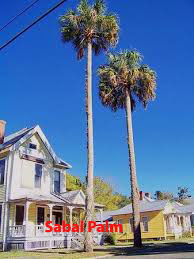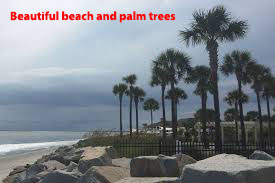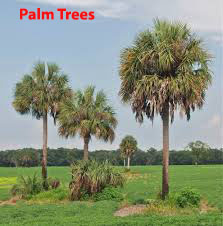Introduction to Palm Trees in South Carolina
South Carolina is one of the most favorite destinations of travelers. Palm trees in South Carolina play a significant role in the picturesque landscaping and forming the beautiful state beaches. They enhance and redefine the beautiful coastal charm of the state. The conditions are suitable for flourishing palm trees in South Carolina.
Swaying in the breeze, iconic fronds, and beautiful and smooth colors of palm trees create a tropical ambiance. The beauty of these plants and trees attracts both locals and tourists alike. Palm trees flourish in warm and humid climates and South Carolina has the most ideal environment for palm trees to flourish and palm tree maintenance.
Lining across the streets of Charleston, beautifying private gardens, and increasing the charm and beauty of the beaches, palm trees in South Carolina are some of the beloved features of the state. They enhance the beauty and landscape of the state.
Types of Palm Trees Found in South Carolina
South Carolina is home to a variety of palm trees. The conditions are suitable for many varieties of palm trees to flourish, so there are many varieties that add beauty, charm, and a unique touch to the landscaping and scenery of South Carolina.
Sabal Palmetto:
Known as the cabbage palm sabal palmetto is the most commonly seen palm tree in South Carolina. Sabal palmetto is also known as a symbol of Southern heritage.

Pindo Palm:
Another palm tree that is adding beauty to the state’s scenery is the pindo palm. It is known for its beautiful blue-gray leaves and edible fruit.
Windmill Palm:
Famous for its hard nature windmill palm is another type that is found in South Carolina. It can tolerate cooler conditions.
Saw Palmetto:
Saw palmetto is also found in the region which enhances the beauty and landscaping of South Carolina.
Needle Palm:
Needle palm trees are also abundant in the region with their unique sizes and textures that add beauty to the state and diversify the array of palm trees in South Carolina.
These are the varieties of palm trees in South Carolina that are making public and private landscapes attractive alike.
Climate and Conditions for Growing Palm Trees
Mild winters and hot and humid summers of South Carolina are conducive for the growing and flourishing varieties of palm trees. Palm trees thrive in hot and humid conditions, and South Carolina has the perfect conditions for palm trees to thrive and for palm tree maintenance.
The coastal regions of the state are in particular the most perfect places for palm trees to thrive. The coastal areas have sandy soil and moisture from the ocean which are conducive for palm trees. But in winter, they can have some hard cold conditions.
Proper care is essential for palm trees to flourish. Soil drainage, avoiding waterlogging, regular watering, and protection from strong conditions are winds are necessary for the good growth and health of palm trees.
Overall, there are ideal conditions and environments for palm trees in South Carolina to thrive. They add scenery, landscape, beauty, and lush to the state’s tropical landscaping.
History and Cultural Significance of Palm Trees in the State
Palm trees in South Carolina have some special connections and heritage with its history and culture. The Sabal Palmetto has a special place in the history of the state and is considered a symbol of the state’s heritage and resilience.
Palmetto play a significant role during the American Revolutionary War. Fort Moultrie on Sullivan’s Island was constructed from palmetto logs and it absorbed all the impact of cannonballs. It played a crucial role in securing a crucial victory.
This historical event paved the way for Palmetto to be the state’s symbol. It eventually made its way to the South Carolina flag and its seal. Palmetto also represents the state’s natural beauty, coastal life, and tropical landscaping along with its historical importance.
You May like:
Palm trees in South Carolina are associated with vacations, scenic beaches, and relaxation Beautiful images of palm trees evoke a sense of tropical allure and tranquility attracting torrents of tourists all around the year.
Planting Palm Trees in South Carolina: Tips and Considerations
Take care of some basic tips and tricks while planting palm trees in South Carolina. Ensure you follow proper guidance to plant a palm tree in South Carolina and consider some factors to ensure they thrive and flourish.
First, consider some basic factors that can affect the growth and health of palm trees in South Carolina. Sunlight, temperature, soil type, and location are the most affecting factors that must be considered before planting a palm tree in South Carolina.
Cold-hardy species such as windmills are more suitable for inland regions of the state due to the weather conditions. Coastal regions can accommodate a broad variety of palm trees due to their consistent moisture and sandy soil.
Prevent root rot by selecting a well-drained site as palm trees are waterlogged soil sensitive. Dig a hole for the tree twice of the root ball and shallower. Ensure you arrange proper drainage for palm tree maintenance.
Position the tree properly in the hole and backfill the hole with a mixture of organic compost, matter, and native soil. Ensure the root ball’s top is above the ground level. Water the plant thoroughly and properly. Ensure consistent moisture in the first few months.
for more info:
South Carolina Living:
https://scliving.coop/home–garden/success-with-palms
Provide shade to the young palm trees to reduce any transplant shock and palm tree maintenance. Mulch around the base to retain the soil moisture and protect the roots. Use a balanced dose of formulated fertilizers for palm trees for healthy, thriving, and beautiful trees.
You can enhance the beauty and landscape of your garden or site with tropical scenery by successfully nurturing palm trees and palm tree maintenance in South Carolina by following these simple steps and tricks.
The Role of Palm Trees in South Carolina’s Landscapes
Palm trees in South Carolina play a vital role in shaping the distinctive tropical flair and natural beauty of the state. Palm trees are proving a visual connection along the coastal regions and highways, city parks, private gardens, and streets of the state.
Palm trees in South Carolina are used to enhance the landscaping, creating striking sceneries at the backdrop of sunset or ocean. Due to low palm tree maintenance and their ability to thrive in compact spaces, they are considered the most suitable trees.

They are used to beautify public spaces, such as waterfronts, streets, parks, beaches, and private gardens. They attract locals and tourists alike. Palm trees create landscaping in residential areas. They complement garden areas, patios, and swimming pools.
Palm trees in South Carolina also provide food to different species and enhance the ecosystem of the state. They offer shade, and cooling effects, and mitigate heat in the urban surroundings through their tall trunks and broad fronds.
Palm trees are an important and integral part of South Carolina’s beautiful and charming landscaping. They enhance the beauty, represent the heritage, feed birds and insects, and control the heat of the urban area.
Common Diseases and Pests Affecting Palm Trees
Palm trees are strong and resilient to diseases and issues but they may be susceptible to various problems, pests, and diseases. They can affect the health, beauty, and appearance of the palm trees. some common diseases are:
Ganoderma Butt Rot:
Caused by a fungal pathogen, Ganoderma butt rot attacks the roots and base of the plants. They cause decay and structural failure of the plant. The symptoms may include root rot and yellowing of the fronds.
Palm Tree Wilt:
Caused by various factors, such as fungal infections, nutrient deficiencies, and pest infestation palm tree wilt can cause a palm tree failure and decline. This can be harmful if not addressed promptly.
Palm Aphid:
This disease feeds on the sap of the palm tree which can cause yellowing of the fronds and curling of the leaves. If not acted on time, it can also lead to the decline of the plant.
Red Palm Weevil:
Red palm weevils cause severe damage to the palm tree by burrowing into the trunk of the plant. They weaken the stem of the plant and cause structural failure.
Proper palm tree maintenance can help you keep your plants healthy. Fertilize properly, inspect regularly, and detect the problem as early as possible to prevent any problems and diseases.
Also Read:
Following this palm tree maintenance, acting on time, and removing any problem found abruptly can help you maintain a lavish, beautiful, and lush garden of palm trees in South Carolina.
Palm tree maintenance and Care for Healthy trees
palm tree maintenance and care involve some key practices to ensure the health and longevity of Palm trees in South Carolina. Water them regularly during hot and dry seasons. Palm trees require infrequent and deep watering. Overwatering can cause root rot.
Fertilization can play a vital role in the health and productivity of palm trees in South Carolina. Use slow-release, balanced, and specifically palm-formulated fertilizers. Look for any sign of nutrient deficiency and provide the required dose of fertilizer, compost, or supplemental feeding.
Pruning is also necessary for palm tree maintenance and care. Prune full deal fronds only gradually. Do not prune too much at once to avoid any stress. Look for signs of any pests, diseases, or nutrient deficiencies. Address any issue on time to avoid any damage to the plants.
Mulching can play an important role in the health, longevity, and palm tree maintenance. Mulch around the base of the tree to increase and retain soil moisture and regulate temperatures. Organic mulch is best to keep the plants healthy and avoid root rot.
You can enhance your landscaping, beautify your gardens, and enjoy beautiful palm tree gardening by following these simple maintenance practices and tips. You can enjoy the scenery of tropical flair with palm trees in South Carolina.
Where to Buy Palm Trees in South Carolina
Local nurseries and garden centers:
You can find palm trees in South Carolina in different nurseries near you. It is best to get it from local nurseries as you can get expert advice, select from a variety of palm trees, and choose the best specimen.
Online Stores:
You can find the best specimen in any online store. It is cost-effective and easy to buy. You can choose from a variety of palm trees that are suitable for South Carolina.
Specialized palm tree suppliers:
They have a wide range of palm tree species. They can offer you both rare and common varieties of palm trees in South Carolina. They can provide you with good insights about palm tree planting and the required conditions.
You can find the perfect and best specimen by exploring these options. Ensure you check some factors such as the cost of delivery, the size of the tree, and any additional services offered the the seller before you make a purchase. Search for the best available options of palm trees in South Carolina and enjoy gardening.
Cost Factors for Palm Trees in South Carolina
Palm tree cost in South Carolina depends on different factors. They can vary based on various and several factors. Some of the main factors are:
size of the tree:
The cost of palm trees in South Carolina mainly depends on size. Larger palm trees cost more than younger ones because of the cost of cultivation and transportation.

variety of palm trees:
palm tree cost can be affected by the variety of palm trees as well. Common species of palm trees in South Carolina such as Sabal Palmetto can be more affordable than the rare ones. The exotic varieties can cost higher prices.
Source:
The source that you acquire a plant from can also affect the palm tree cost. The price, delivery charges, and additional services may vary from seller to seller. Online stores may offer compatible prices.
Delivery and installation:
Delivery and installation services may affect the palm tree cost. Larger plants may need a professional installation that will add up the extra cost to the aggregate charges of palm trees in South Carolina.
Seasonality:
palm tree costs and palm tree prices can also vary depending on seasonality. Palm trees in South Carolina may cost more during peak seasons while they might be less expensive in off-peak seasons and lead to better deals and discounts.
You can make an informed and best decision following these simple and easy steps. You can calculate palm tree cost easily by considering these factors and estimating a better cost plan for your palm trees in South Carolina.
Price Range of Different Palm Tree Varieties
Palm tree cost and palm tree prices vary depending on different factors. Different varieties and species of palm trees in South Carolina range from $50 to $500. Here is a general breakdown of the price range of different and common varieties.
- Sabal Palmetto (Cabbage Palm):
Depending on the size of the plant this state-symbol palm tree is relatively affordable. This can range from $50 to $300.
- Pindo Palm (Jelly Palm):
This is an attractive plant and its fruit is edible. This plant can cost from $75 to $350. However, the palm tree cost will depend on the size and maturity of the plant.
- Windmill Palm:
It is resilient against hard conditions and it makes it more valuable. It may cost from $100 to $400 depending on the size, delivery, and maturity of the plant.
- Saw Palmetto:
Saw palmetto mostly used as low shrub or ground cover. palm tree cost can differ based on size and number of plants but it usually costs between $40 to $200.
- Needle Palm:
Its small size, attractive appearance, and hardiness make it one of the most popular choices for landscaping. It may range from $50 to $250.
These prices are estimates depending on different factors and elements. The price of palm trees in South Carolina can fluctuate based on availability, delivery, planting services, and demand. Check local nurseries for the best and most accurate palm tree costs and prices.
Additional Costs: Planting, Maintenance, and Transport
When you plan to plant a palm tree in South Carolina consider some other costs along with the purchasing price. Here are some factors that may cost you extra money.
- Planting Costs:
Professional planting services can affect palm tree costs. it may range from $100 to $500 depending on the size of the tree, digging the hole, preparing the site, and placing the tree properly.
- Maintenance Costs:
palm tree maintenance can also add up to the costs of palm trees in South Carolina. palm tree trimming cost, watering, fertilizing, and pruning are some of the maintenance costs that can range from $100 to $300 per year.
- Transport Costs:
Transport expenses can also add up to the total expenses of palm tree prices. Shipping can vary depending on distance, size of the plants, and sourcing. It may range from $50 to $300.
- Fertilization and Soil Amendments:
Fertilization plays a pivotal role in the health and beauty of the palm trees in South Carolina. Fertilizers may cost $20 to $50 per bag. Soil supplements and mulching material can also cost up to $20 to $100.
palm tree cost and palm tree prices can be affected by these additional factors and elements. You can estimate a more accurate budget or costs of the palm trees in South Carolina by considering these factors.
Comparing the Cost of Palm Trees to Other Ornamental Plants
You can more accurately estimate palm tree prices by comparing their prices with other plants that are used to enhance the landscaping of the state. Comparison between palm trees in South Carolina and other plants can provide valuable insights.
- Palm Trees vs. Trees:
palm tree cost can be higher compared to the other traditional trees such as maples, and oaks. Palm trees require higher initial costs and due to their slower maturity, they cost higher than the other plants.
- Palm Trees vs. Shrubs:
Palm trees in South Carolina can offer unique visuals but they may cost higher than the shrubs such as holly and boxwoods. Shrubs cost lower prices due to their small sizes.
- Palm Trees vs. Groundcovers:
Groundcover plants can fill up spaces perfectly but they do not provide dramatic visuals. Groundcover plants are usually less expensive than the palm trees in South Carolina.
- Palm Trees vs. Perennials:
Perennials may cost lower prices than the palm trees. Perennials such as hostas and daylilies are easier to replace, and more affordable than palm trees. However, the aesthetic visuals of palm trees satisfy their initial cost.
palm trees in South Carolina may cost more than other ornamental plants. however, the unique appearance, beautiful structure, and aesthetic visuals can offer a higher value to the landscaping of your garden.
Future Trends and Prospects for Palm Trees in South Carolina.
Palm trees in South Carolina have an upward trend and they are going to play a significant role in the landscaping of South Carolina. The demand will increase with the evolving conditions.
- Increased Popularity of Tropical Landscaping:
Palm trees in South Carolina create tropical, resort-like, and beautiful environments. Developers and homeowners seek to enhance the beauty of residential and commercial properties with palm trees.
- Focus on Cold-Hardy Varieties:
Usage of cold hardy varieties will surge due to the changing climate conditions. Windmills are popular for their withstand against hard conditions and they may further to the inland of the state.
- Sustainable Landscaping Practices:
Palm trees require low water and low maintenance requirements. low palm tree maintenance making it favorable for gardners and developers alike to catch up with the growing awareness and needs of sustainable practices.
- Advancements in Cultivation Techniques:
Advancements in technology and farming techniques may ease the cultivation and farming of palm trees in South Carolina and reduce palm tree costs which will surge the use of palm trees and potential new varieties.
- Urban Integration:
With the expansion of urban areas, demand for palm trees in South Carolina will surge to integrate the city landscapes. The stunning visual effects of palm trees will continue to enhance the livability of the cities.
With the new trends, technology, lowering palm tree prices, and beautiful visual effects palm trees will continue to grace the elegance, beauty, and landscapes of the state.
Conclusion
Palm trees in South Carolina are a unique feature. They enhance the beauty of the state by offering aesthetic visual appeal and practical benefits. They are increasing the beauty of private gardens, urban streetscapes, and the charm of the coastal regions. They hold a special place in the history of the state specifically Sabal Palmetto which is the symbol of the state.
Palm tree cost or palm tree prices may vary depending on different factors such as size, variety, source, season, and location. While budgeting for the purchase or plantation of palm trees, keep in mind the extra costs such as palm tree trimming cost and palm tree maintenance. You can accurately estimate the costs and prices or budget of a palm tree by following these factors.
Palm trees in South Carolina have different varieties. Various varieties of Palm trees in South Carolina are Saw Palmetto, Windmill Palm, and Pindo Palm. Each one of these varieties brings a unique quality to the landscapes of the state. They may have higher initial higher prices but their aesthetic visual justifies these initial costs compared to other ornamental plants.
Palm trees are resilient against diseases, hard conditions, and pests but they sometimes suffer some problems due to these issues. proper palm tree maintenance is required to keep your palm trees safe, healthy, and thriving. Balanced fertilization, pest control, watering, and timely action against any sign of diseases can help you ensure the longevity and health of the trees.
Advancements in tech, advanced farming techniques, and growing sustainability practices will contribute to the increased use and cultivation of palm trees in South Carolina. the inclination of the people toward tropical and resort-like visuals will also play a role in the upward trend in the use of the palm trees in South Carolina.
Palm trees are not just a decorative plant or element in South Carolina. They have an integral part in the history and heritage of the state. Sabal Palmetto is recognized as the state symbol after playing a crucial role in the victory in the American Revolutionary War.
You can make an informed decision by understanding the palm tree cost, palm tree prices, and palm tree maintenance. Searching and understanding initial cost, varieties, care requirements, and planting techniques can help you ensure a beautiful, vibrant, lavish, and aesthetic outdoor space in your home or garden for the years to come.
FAQs about Palm trees in South Carolina:
Can palm trees grow in South Carolina?
Yes, South Carolina has a perfect climate and soil conditions for the thriving growth of palm trees. There are a variety of palm trees in South Carolina.
Why does South Carolina have a palm tree?
South Carolina’s conditions are most suitable for palm trees. sandy beach soil and hot and humid weather help palm trees grow easily and add aesthetic visuals to the state’s beauty.
What beach in South Carolina has palm trees?
Palm trees add beauty to beaches and inland regions of South Carolina but the most prominent of all of them is Myrtle Beach. Myrtle Beach is relatively warm in winter and most suitable for palm trees.
What is the main tree in South Carolina?
Sabal Palmetto is the main palm tree in South Carolina. Sabal palmetto is recognized as a symbol of the state and it earned its place on the flag and seal of the state after playing an important role in victory in the American Revolutionary War.
What state grows the most palm trees?
Florida is the state which has the most palm trees in the United States of America. Florida has 12 native species of palm trees.


7 thoughts on “10 Stunning Ways For Thriving Palm Trees In South Carolina”